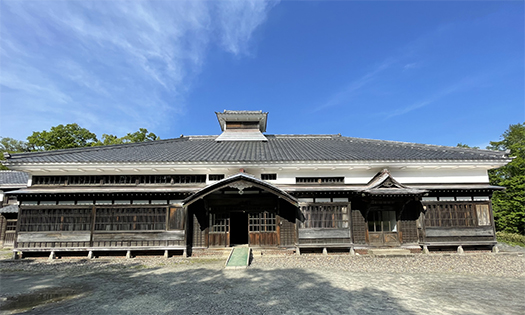
いま手掛けている企画について用件があって、北海道開拓の村を久しぶりに訪問。
古い住宅建築がひとつの「文化遺産」としてその味わい、楽しみ方があるというそういった領域が確立し、全国でそのような「テーマパーク」が成立している。
多くの場合それらは公営で行われている事業であって、単独の採算性、効率の考え方からは成立しにくいのだろう。しかし観光事業領域全体で考えれば、不可欠な地域訴求要素ということになるので、地域の観光産業振興という枠で、必要な公共投資と考えられる。
そういうなかでも「北海道開拓の村」というコンセプトは比較的にわかりやすいもの。150年以上の歴史の蓄積の中で、とくに建築は容易に更新解体されるので意図的に保存する意味は高い。
この写真の青山家漁家住宅は、そういうなかでも「産業遺産」的な意味合いの建築。
北海道の歴史の中で「ニシン漁」という産業領域が非常に大きなものだったことは、イマドキの世代にはピンと来ないようになっていると思う。日本社会に対して北海道は長く原材料供給地域として認識されてきて、江戸期の高田屋嘉兵衛のように綿花栽培の「肥料」を北海道から供給することで大きな利潤を生んできた。
明治以降でそういった領域での大成功者が、山形県出身の青山氏。ニシンの「建て網」漁の大成功者として栄華を極めたとされている。そういった「産業痕跡」というのは、収奪型産業らしく、現代ではその発展したあとの産業構造を見出すことはむずかしい。やはり根を持った産業とは言い難く、うたかたのように消えてしまっている。
だからこそこのように建築遺構として保存することが意味があるのだろう。たぶんイマドキの子どもたちは、ニシン漁の歴史は、このような遺構からだけ認識を得ていることだろう。
・・・というようなことだったけれど、以前にお世話になった研究員の方がこちらの管理部門にいたので、今後のご協力もお願いしたく訪問面談もさせていただいた。
十数年ぶりでしたが、いまや中核的な存在として北海道の歴史の証言者の迫力も持たれていた。しばし、歴史の継承のようなテーマについて、自分たち年代の共通課題であると腑に落ちていた次第。人間の役割にはさまざまなモノがあるでしょうが、加齢してくると、そういった部分の役割を目的的に掘り起こしていく必要があることが見えてくる。
古建築とその人間との関わりのような部分。大きなテーマだと情報共有しておりました。
English version⬇
Inheriting “history” as noticed in the Hokkaido Kaitakushi no Mura
It is necessary to testify to the history that herring fishing was the representative “industrial structure” of the Hokkaido region. Only old buildings will be able to show this.
I visited the Hokkaido Kaitakunomura for the first time in a long time to discuss a project I am working on.
Old residential architecture has established itself as a “cultural heritage” that can be enjoyed and appreciated in its own way, and such “theme parks” have been established all over Japan.
However, in many cases, these are publicly operated projects, and it is difficult to establish them from the standpoint of stand-alone profitability and efficiency. However, if we consider tourism as a whole, it is an essential element of regional appeal, and therefore, it can be considered a necessary public investment within the framework of regional tourism industry promotion.
The concept of “Hokkaido Kaitakushi no Mura” (Hokkaido Development Village) is relatively easy to understand, and its deliberate preservation is highly meaningful, especially since the architecture can be easily renewed and dismantled after more than 150 years of accumulated history.
The Aoyama Fisherman’s House in this photo is one such example of an “industrial heritage” building.
The fact that the industrial domain of “herring fishing” was a very large part of Hokkaido’s history is not so obvious to the current generation. Hokkaido has long been recognized by Japanese society as a raw material supply area, and as in the case of Kahei Takataya in the Edo period, large profits were generated by supplying “fertilizer” for cotton cultivation from Hokkaido.
Aoyama, a native of Yamagata Prefecture, has been a great success in this area since the Meiji period. He is said to have reached the height of his prosperity as a highly successful herring fisherman using the “ken-net” fishing method. Such “industrial traces” seem to be a predatory industry, and it is difficult to find the industrial structure that has developed since then. It is difficult to say that it was an industry with roots, and it has disappeared like a shadow.
That is why it is meaningful to preserve them as architectural remains. Perhaps today’s children are aware of the history of herring fishing only from the remains of such structures.
I had not been to the site for more than 10 years, but I had visited the site and was impressed with the history of the herring fishery and the history of the fishery.
It had been more than ten years since I had visited there, but he was now a core member of the organization and had the power of a witness to Hokkaido’s history. For a while, I was struck by the fact that the theme of historical inheritance is a common issue for our age group. There are probably a variety of things that play the role of human beings, but as we age, I suppose we need to purposefully uncover the role of such parts of our lives.
The part like the relationship between ancient architecture and human beings. We recognized this as a major theme.
Posted on 5月 24th, 2024 by 三木 奎吾
Filed under: 日本社会・文化研究







コメントを投稿
「※誹謗中傷や、悪意のある書き込み、営利目的などのコメントを防ぐために、投稿された全てのコメントは一時的に保留されますのでご了承ください。」
You must be logged in to post a comment.